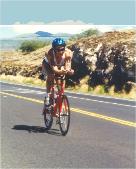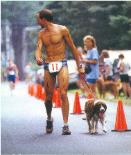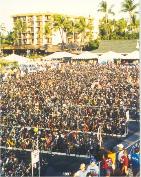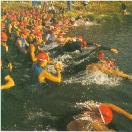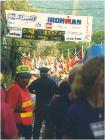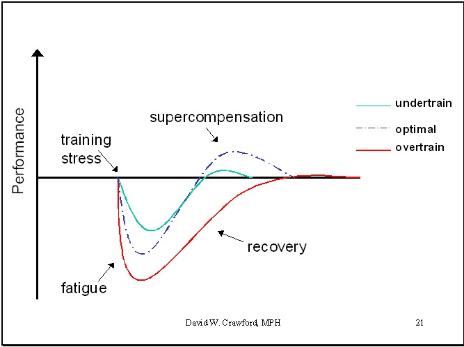


Approach to Training
As a career Health Scientist, I have long been a proponent of using sound training
principles and methods supported by evidence developed by the exercise science
research community. Through years of training and racing experience at a high
level and with an understanding of human physiology, I have been able to evolve
and refine a training approach that can be successful for any endurance athlete.
Fundamental to my approach is
periodization, or planning of the overall training cycle,
quality and specificity of training relative to volume and intensity, and
balance of training stress and recovery to facilitate adaptation
Over the years, I have looked critically at claims of “revolutionary” developments or
hyped fads in training that do not have any actual basis other than someone
reports it as the "latest and greatest." In essence, there have been no drastic
changes in what constitutes a sensible approach to training in recent years. Rather,
changes in training tend to come in small increments, and trends gradually develop
as the latest physiological research is absorbed into the mainstream..
Often, the practical physiological information provided by researchers simply
reinforces or helps explain why certain approaches to training in endurance sports
have been universally accepted by athletes and coaches over time. The research
helps define the physiological benefits that can be expected by the application of
various training methods.
For instance, it is well accepted that training for a specific event should emphasize
the conditioning of the energy systems involved in the performance of that
particular event. In other words, do in training what you plan on doing in racing.
What sometimes can be a source of controversy or confusion, however, is the
proper mix of training throughout a training cycle. Training periodization is a well-
established approach that helps address this issue.
Periodization
I am an advocate of periodization, an organized, planned approach in which an
overall training cycle (often a year) is broken down into shorter periods (weeks or
months). Each period has a different emphasis as to how training stresses are
applied. Periods are usually structured around the racing season and your goals
and purposes for competition.
The basic premise of periodization is this: reaching your maximum physiological
potential in competition can best be accomplished by varying training stresses of
frequency, intensity and duration during the periods leading up to important
competition. You build to your highest levels of performance at the right time by
adjusting the emphasis of the training and adaptation of the various physiological
systems during each period of the overall training cycle.
Periodization is useful for addressing the concern that you cannot maintain peak
physiological performance for extended periods of time without risking overtraining,
burnout, illness or injury. Thus, a key component of periodization is incorporation
of appropriate rest and recovery, not only at the end of a season, but throughout
the overall training cycle.
Quality versus Quantity
Continuous, high volume training for the sake of high volume too often can result in
overtraining, burnout, injury and a decision to leave a sport that is seen as too
demanding. Training too fast all of the time can have the same result. Training
should be of a quality and specificity to help you meet your goals and should be
based on current level of fitness, past experience, and your innate abilities. Each
athlete is unique.
Training needs to be individualized and workouts prescribed without overdoing
distance, time or speed to the detriment of athletic performance or overall well-
being. This is particularly important for the athlete with limited time to devote to
training.
That said, the key to training for endurance events is increasing both training
volume and intensity. Both are needed to fully maximize the development of the
aerobic capacity of the athlete. Below is a graphical depiction of the typical
relationship of volume and intensity during the overall training cycle leading up to
key races.
As the race season draws near and both volume and intensity have progressed,
volume is reduced in favor of even higher intensity training. Maintaining high
volume and high intensity for too long carries a much greater risk of overtraining
and injury. The reduced volume does not detract from overall fitness. Instead, the
purposeful higher intensity training at this time brings fitness to a physiological peak
in time for the key race(s).
Aerobic capacity can only be fully developed by adequately stressing the oxygen
delivery, oxygen utilization and the other physiological components that comprise
aerobic capacity. It is not simply a matter of going out every day and doing easy,
long distance training – long, slow distance trains you to go long and slow. Rather,
it is a complex process that requires a blend of easy to moderate endurance efforts,
shorter duration higher intensities of effort and properly timed recovery to allow the
body to adapt to the training. Included in an appropriate training program are
workout intensities that are designed to raise the lactate threshold (often referred to
as anaerobic threshold) and maximize VO2max (maximum capacity to utilize oxygen
in doing specific work).
Whether training for Olympic distance events (~ 2+ hours duration) or the Ironman
(~8+ hours), both are endurance events requiring a highly developed aerobic
capacity to maximize race potential. Ultra-distance events are raced at a slower
pace compared to the shorter events. Yet, improvements in lactate threshold and
VO2max result in more efficient and effective racing even at the longer distance.
Hence, intensity in training is still important to the overall racing potential of those
focused on the Ironman distance. The balance of intensity and volume will differ
somewhat, but the principles of training remain the same.
In my mind, there are three well-known triathletes whose accomplishments suggest
they were able to find the balance between volume and intensity for racing at
Olympic and Ironman distances.
Mark Allen: it took him several tries at the Ironman distance, but Mark was one of
the fastest Olympic Distance racers in the world and accomplished at the Ironman
distance with the fastest Hawaii Ironman from 1989 until 1996 (8:09).
Luc Van Lierde: the Belgian was one of the fastest Olympic distance racers in the
world in the summer of 1996, the same year he set the new Hawaii Ironman record
of 8:04 (and that included a 3 minute penalty!).
Karen Smyers: in 1995, she won the Hawaii Ironman and four weeks later won the
women's ITU World Championships, Olympic Distance, in Cancun, Mexico.
The bottom-line? Olympic Distance and Ironman training are not necessarily
mutually exclusive during the same season. The principles of training aerobic
capacity are the same, but the balance of intensity and volume at a given time
during the training cycle is shifted.
Training Stress, Recovery and Adaptation
An important piece of the puzzle is the balance of training stress and recovery to
allow the body to adapt to increased volume or intensity. As described above,
periodization integrates recovery throughout the training cycle. Below is a graph
illustrating physiological adaptation to a training stress when adequate recovery is
facilitated. It also shows how that response may vary for optimal, excessive and
inadequate training stress. Yakovlev uses the term supercompensation to describe
this adaptation.
Training places a physiological load on the body, resulting in fatigue and a decline
in performance ability. Improvement in performance can only occur with adequate
recovery. Inadequate training stress may bring only small improvement.
Overtraining requires excessive recovery and may not show any improvement.
Optimal training with adequate recovery results in improved performance abilities
due to the adaptive physiological/metabolic potential.
This model can be applied to all periods of the overall training cycle, whether an
individual workout, several days of building or longer periods of preparation. Of
course, one of the challenges of coaching any athlete is to find the right balance of
stress and recovery for each individual -- that's why coaching is as much art as it is
science.
Experience of the Athlete
The novice endurance athlete is better served by focusing initially on learning the
skills and gradually developing the aerobic capacity for the more modest endurance
events, e.g., Olympic distance or shorter. Intensity also needs to be constrained
until significant adaptation to training has occurred. Those skills and endurance will
be directly transferable to the longer distance as the body is able to adapt to
increasing volume.
For the more experienced and fit endurance athlete, the goal in training is two-fold.
First, significant training volume must occur within the typical low and moderate
intensities normally associated with endurance training. Second, higher intensity
training that addresses all of the physiological components of aerobic capacity must
be incorporated in a progressive, timely approach that allows for the highest quality
of training based on individual abilities. Both volume and intensity must be
tempered by planned rest and recovery. In this way, the probability of reaching
your physiological potential is maximized.
As a career Health Scientist, I have long been a proponent of using sound training
principles and methods supported by evidence developed by the exercise science
research community. Through years of training and racing experience at a high
level and with an understanding of human physiology, I have been able to evolve
and refine a training approach that can be successful for any endurance athlete.
Fundamental to my approach is
periodization, or planning of the overall training cycle,
quality and specificity of training relative to volume and intensity, and
balance of training stress and recovery to facilitate adaptation
Over the years, I have looked critically at claims of “revolutionary” developments or
hyped fads in training that do not have any actual basis other than someone
reports it as the "latest and greatest." In essence, there have been no drastic
changes in what constitutes a sensible approach to training in recent years. Rather,
changes in training tend to come in small increments, and trends gradually develop
as the latest physiological research is absorbed into the mainstream..
Often, the practical physiological information provided by researchers simply
reinforces or helps explain why certain approaches to training in endurance sports
have been universally accepted by athletes and coaches over time. The research
helps define the physiological benefits that can be expected by the application of
various training methods.
For instance, it is well accepted that training for a specific event should emphasize
the conditioning of the energy systems involved in the performance of that
particular event. In other words, do in training what you plan on doing in racing.
What sometimes can be a source of controversy or confusion, however, is the
proper mix of training throughout a training cycle. Training periodization is a well-
established approach that helps address this issue.
Periodization
I am an advocate of periodization, an organized, planned approach in which an
overall training cycle (often a year) is broken down into shorter periods (weeks or
months). Each period has a different emphasis as to how training stresses are
applied. Periods are usually structured around the racing season and your goals
and purposes for competition.
The basic premise of periodization is this: reaching your maximum physiological
potential in competition can best be accomplished by varying training stresses of
frequency, intensity and duration during the periods leading up to important
competition. You build to your highest levels of performance at the right time by
adjusting the emphasis of the training and adaptation of the various physiological
systems during each period of the overall training cycle.
Periodization is useful for addressing the concern that you cannot maintain peak
physiological performance for extended periods of time without risking overtraining,
burnout, illness or injury. Thus, a key component of periodization is incorporation
of appropriate rest and recovery, not only at the end of a season, but throughout
the overall training cycle.
Quality versus Quantity
Continuous, high volume training for the sake of high volume too often can result in
overtraining, burnout, injury and a decision to leave a sport that is seen as too
demanding. Training too fast all of the time can have the same result. Training
should be of a quality and specificity to help you meet your goals and should be
based on current level of fitness, past experience, and your innate abilities. Each
athlete is unique.
Training needs to be individualized and workouts prescribed without overdoing
distance, time or speed to the detriment of athletic performance or overall well-
being. This is particularly important for the athlete with limited time to devote to
training.
That said, the key to training for endurance events is increasing both training
volume and intensity. Both are needed to fully maximize the development of the
aerobic capacity of the athlete. Below is a graphical depiction of the typical
relationship of volume and intensity during the overall training cycle leading up to
key races.
As the race season draws near and both volume and intensity have progressed,
volume is reduced in favor of even higher intensity training. Maintaining high
volume and high intensity for too long carries a much greater risk of overtraining
and injury. The reduced volume does not detract from overall fitness. Instead, the
purposeful higher intensity training at this time brings fitness to a physiological peak
in time for the key race(s).
Aerobic capacity can only be fully developed by adequately stressing the oxygen
delivery, oxygen utilization and the other physiological components that comprise
aerobic capacity. It is not simply a matter of going out every day and doing easy,
long distance training – long, slow distance trains you to go long and slow. Rather,
it is a complex process that requires a blend of easy to moderate endurance efforts,
shorter duration higher intensities of effort and properly timed recovery to allow the
body to adapt to the training. Included in an appropriate training program are
workout intensities that are designed to raise the lactate threshold (often referred to
as anaerobic threshold) and maximize VO2max (maximum capacity to utilize oxygen
in doing specific work).
Whether training for Olympic distance events (~ 2+ hours duration) or the Ironman
(~8+ hours), both are endurance events requiring a highly developed aerobic
capacity to maximize race potential. Ultra-distance events are raced at a slower
pace compared to the shorter events. Yet, improvements in lactate threshold and
VO2max result in more efficient and effective racing even at the longer distance.
Hence, intensity in training is still important to the overall racing potential of those
focused on the Ironman distance. The balance of intensity and volume will differ
somewhat, but the principles of training remain the same.
In my mind, there are three well-known triathletes whose accomplishments suggest
they were able to find the balance between volume and intensity for racing at
Olympic and Ironman distances.
Mark Allen: it took him several tries at the Ironman distance, but Mark was one of
the fastest Olympic Distance racers in the world and accomplished at the Ironman
distance with the fastest Hawaii Ironman from 1989 until 1996 (8:09).
Luc Van Lierde: the Belgian was one of the fastest Olympic distance racers in the
world in the summer of 1996, the same year he set the new Hawaii Ironman record
of 8:04 (and that included a 3 minute penalty!).
Karen Smyers: in 1995, she won the Hawaii Ironman and four weeks later won the
women's ITU World Championships, Olympic Distance, in Cancun, Mexico.
The bottom-line? Olympic Distance and Ironman training are not necessarily
mutually exclusive during the same season. The principles of training aerobic
capacity are the same, but the balance of intensity and volume at a given time
during the training cycle is shifted.
Training Stress, Recovery and Adaptation
An important piece of the puzzle is the balance of training stress and recovery to
allow the body to adapt to increased volume or intensity. As described above,
periodization integrates recovery throughout the training cycle. Below is a graph
illustrating physiological adaptation to a training stress when adequate recovery is
facilitated. It also shows how that response may vary for optimal, excessive and
inadequate training stress. Yakovlev uses the term supercompensation to describe
this adaptation.
Training places a physiological load on the body, resulting in fatigue and a decline
in performance ability. Improvement in performance can only occur with adequate
recovery. Inadequate training stress may bring only small improvement.
Overtraining requires excessive recovery and may not show any improvement.
Optimal training with adequate recovery results in improved performance abilities
due to the adaptive physiological/metabolic potential.
This model can be applied to all periods of the overall training cycle, whether an
individual workout, several days of building or longer periods of preparation. Of
course, one of the challenges of coaching any athlete is to find the right balance of
stress and recovery for each individual -- that's why coaching is as much art as it is
science.
Experience of the Athlete
The novice endurance athlete is better served by focusing initially on learning the
skills and gradually developing the aerobic capacity for the more modest endurance
events, e.g., Olympic distance or shorter. Intensity also needs to be constrained
until significant adaptation to training has occurred. Those skills and endurance will
be directly transferable to the longer distance as the body is able to adapt to
increasing volume.
For the more experienced and fit endurance athlete, the goal in training is two-fold.
First, significant training volume must occur within the typical low and moderate
intensities normally associated with endurance training. Second, higher intensity
training that addresses all of the physiological components of aerobic capacity must
be incorporated in a progressive, timely approach that allows for the highest quality
of training based on individual abilities. Both volume and intensity must be
tempered by planned rest and recovery. In this way, the probability of reaching
your physiological potential is maximized.
| TriDavid Coaching |

